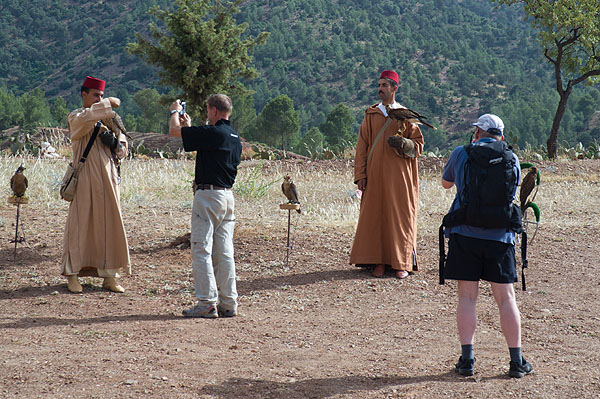Sony Alpha 100 June 2006 launch report
Shortly before the June 6th 2006 worldwide launch of the Sony Alpha digital SLR system the European press learned that major title editors would meet in Marrakesh for the unveiling of the Alpha 100. No-one anticipated being driven miles into the desert-like countryside of Oued Nfis for the experience of a night under canvas after witnessing feats of Berber horsemanship and a massive pyrotechnic intro! Read David Kilpatrick’s original report from the Summer 2006 edition of Photoworld magazine. Please note this is a long, fully detailed and illustrated article split across several pages. Be sure to click the next page at the end of each one to continue reading.

Many, indeed, didn’t have their cameras to hand when the show descended on fed and watered journalists, but I had fitted my 28mm f/2 lens to my 7D, set it for ISO 1600 and tungsten light, dialled minus two stops compensation and was ready to brave the dust-storm raised by the riders.
In between shots, the camera was wrapped in my hanky, well enough to stop the outside getting the good coating of sand which hair, clothes, and any remaining food quickly gathered.

Everyone was worried about the dust. Dust is the bane of digital SLRs, getting on the sensor and requiring repeated cleaning procedures. Why had they brought us here for a DSLR launch? Morocco in June – dust, heat which is notoriously bad for CCD noise levels, burning overhead desert sun combining harsh contrast with flat subject-matter:
Alpha’s challenge

In the morning we learned why. The new Sony Alpha 100 has an anti-dust process which adapts the CCD movement used for the former Konica Minolta Anti-Shake, vibrating the assembly at high frequency every time the camera is switched off. Unlike cameras which use a similar process on switch-on, this does not increase start up delay.
The Alpha 100’s 10.2 megapixel CCD – possibly similar to one used in the D200 by Nikon, a company Sony admit they supply sensors to – also has a new anti-dust cover. The glass sheet covering the sensor itself serves as a UV/IR filter, an anti-aliasing filter, and now also has an indium tin oxide coating which reduces static and allows dust particles to be shaken free.
The next day, driven back into the foothills of the High Atlas to visit a Berber agrotourism centre with crafts and activities, the Alpha 100 bodies available for trial use were constantly being passed from hand to hand and lenses changed in the field. I was unable to find a single spot of sensor dust on any of my shots, and it seems that all the journalists had much the same experience.
If there was any disappointment, it was that we only used the cameras in daylight in our particular activity centre. Some other countries’ press groups visited the centre of Marrakesh and the souk, which affords plenty of low-light shooting. Thinking we might continue with evening shooting, I didn’t seek out the interior of the Berber tents for high ISO tests.

However, there was plenty of shade and the sun had some cloud cover. Hand-held shots to test the claims made for the improved version of Anti-Shake – Sony Super Steady Shot Inside – appear to have confirmed its effectiveness, because of over 70 shots taken, not a single one had visible camera shake blur.

In the shade of a heavy woollen canopy, with bright sun outside, this Berber woman was making rag rugs. The exposure for her rug along (shown later in this article) was 1/80th at f/4 with the 28mm f/2 lens at ISO 100. Outside the light demanded 1/1000th at f/4. The shot of her at work, taken without flash on Program setting, was given 1/200th at f/4 by the Alpha 100’s 40-zone metering system. The outside detail though overexposed by two stops has not burned out; this is the original in-camera JPEG, unmodified.
Motion blur of hands included in the shot, yes, but not a trace of photographer wobble. Sony claims 3.5 steps benefit for the improved SSS which literally adds a dimension to the former AS, responding with a more accurate compound compensation to mixtures of horizontal and vertical shake.

A lack of moving targets was tackled when a falconry demonstration started at the end of the afternoon. Fitting the new kit 75-300mm f/4.5-5.6 zoom (like the kit 18-70mm /f3.5-5.6 an updated and restyled verson of the Konica Minolta original) I grabbed a single shot as a hawk came directly towards me filling the entire frame.

The photo press in action
This was on single frame advance and not on continuous focus as I had no time to change. The image was captured as sharply as anyone could possibly expect from a bird moving at that speed and angle relative to the camera. As I changed settings for the next flight, the demonstration ended – but a few shots following the handlers proved that even with the budget price tele zoom, AF is both fast and accurate on the Alpha 100. (Editor’s note – I had the benefit of using my Dynax 7D – some of the photo press, of course, had not come equipped with Alpha compatible bodies. One magazine even used the Sony Morocco trip to test a different camera make – and before running any information on the Alpha system, had run their review bootlegging on the Sony paid-for trip, for a rival brand. Amazing.)
